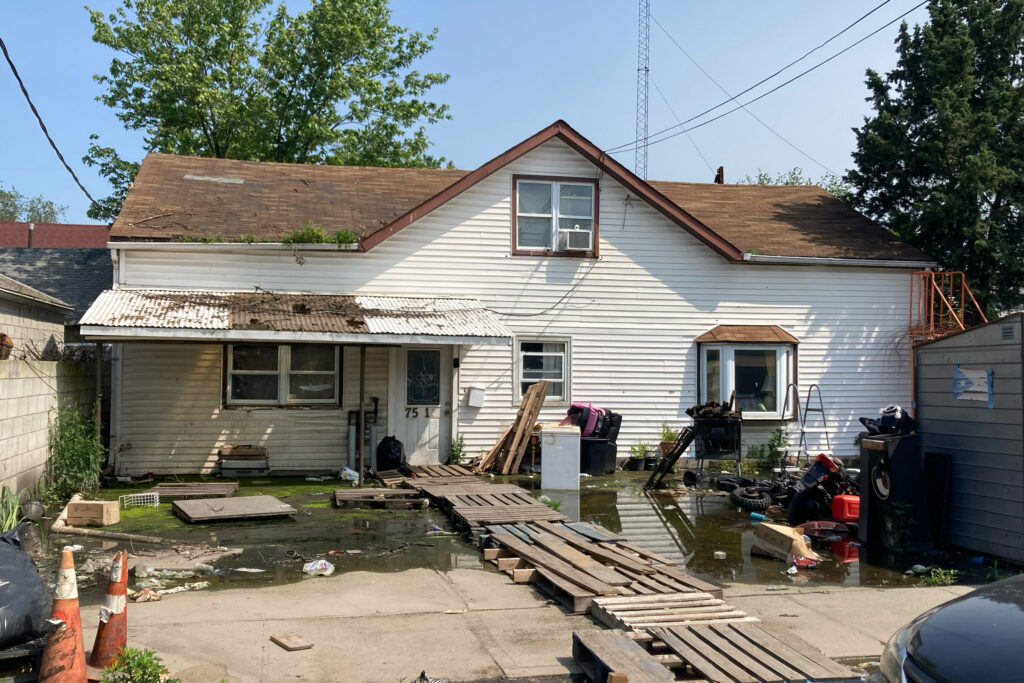Copyright Inside Climate News

It hadn’t rained in two days and yet, on a warm sunny day in early June, in a neighborhood on the border of Brooklyn and Queens known as “The Hole,” some streets were still full of water. That’s because the 12-block area sits around 10 to 15 feet below the surrounding streets—essentially creating a water-trapping bowl. City officials from multiple agencies, as well as community groups including the East New York Community Land Trust, were touring the neighborhood to understand its problems. Abandoned trucks and cars lined the water-filled streets, and city officials talked about the need to remove illegal waste that is often dumped in nearby vacant lots. Debra Ack, of the East New York Community Land Trust, struggled to get her mobility scooter to the other end of certain streets because of pooling water. One resident had even constructed a makeshift bridge out of wooden planks to reach the door of their home because the front yard was flooded. Now, city government may finally be on track to make lasting improvements to living conditions in the area, which is also known as the Jewel Streets because the streets have names such as Ruby and Sapphire. On Tuesday, the Adams administration released the Jewel Streets Neighborhood Plan, which outlines strategies to address flooding and trash and vehicle dumping, and proposes building affordable homes nearby, among other initiatives. “We’re really excited that after two years of community planning, we’re at a place to announce what the city intends to do in terms of investments around the drainage plan and future development in the area,” Michael Sandler, associate commissioner for neighborhood strategies at the city’s Department of Housing Preservation and Development, told Inside Climate News. The Jewel Streets are flood-prone for many reasons, including a high water table and low elevation. These blocks also sit on Spring Creek, a historic waterway that flows into Jamaica Bay. Portions of this creek will be unearthed as part of the neighborhood plan to help drain water from the neighborhood. “We came across this hidden home with hidden truths and devastating outcomes,” resident Julisa Rodriguez said at a press conference Tuesday. She said she has lived in the Jewel Streets for nearly 20 years, and currently resides there with her husband and two children. “Water rising above floor level, leaks and spills from our old and outdated septic tank, mold, rat infestations and, not to mention, my son developing chronic asthma—we have definitely lived under inhumane conditions,” Rodriguez said. Homes in the neighborhood are not connected to New York’s sewer system, either for waste or for rainwater. According to the plan, the city will construct storm sewers to direct and pump rainwater toward a 17-acre city-owned lot a block away from the Jewel Streets. There, the Department of Environmental Protection will build so-called bluebelts—natural drainage areas such as ponds and wetlands—to give the water somewhere to go before it flows out into nearby Jamaica Bay through Spring Creek. Some small bluebelts will also be located in the Jewel Streets—in places where the former creek would naturally flow. The city will also connect the entire area to a new sanitary sewer system. Many homes there still rely on septic tanks and cesspools to treat household wastewater. They can leak, contaminating the groundwater and soil. The plan also signals that the city will offer current residents access to a voluntary buyout program, giving them the option to relocate. “The drainage system will take potentially 10 years to construct, and there are residents who are fed up and are looking for potential change sooner than that,” said Sandler. The program, known as “Resilient Acquisitions,” will be piloted in the Jewel Streets. The city would buy willing residents’ homes and offer them help finding new housing. For those who want to stay, the city will offer to retrofit homes while the local drainage issues are addressed. Ack, who has been following the issues in this neighborhood closely for the past four years, has supported a buyout program “from day one.” But, she told Inside Climate News, some residents interested in the buyout still want to stay in the community. All the Jewel Streets will be rebuilt, complete with sidewalks and street trees, according to the plan. The exact elevation is still being worked out, but all streets must be raised high enough to accommodate a new sewer system. In the south portion of the Jewel Streets, Sandler said, city agencies are considering raising the streets by up to 10 feet—hopefully enough to reconnect streets that are currently dead ends, largely due to height differences. He said there are only five occupied homes in the south Jewel Streets, and the city plans to offer those residents a range of solutions. The plan for the city-owned lot includes not only bluebelts but also the development of mixed-use housing and community amenities. The city plans for the site to include up to 1,400 affordable homes, subsidized by the department of Housing Preservation and Development, and to rezone the area along Linden Boulevard—the large avenue that transects the Jewel Streets—for more development. Once the drainage issues are fixed, the city tentatively plans to encourage the construction of new small homes in the Jewel Streets that fit the neighborhood’s character. The city also hopes to rezone side streets near Linden Boulevard for higher-density housing and community facilities. The city will need several years to complete the project. At Tuesday’s press conference, the commissioner of the Department of Environmental Protection, Rohit Aggarwala, said the funds for the new infrastructure, over $140 million, have already been allocated. The next step is a scoping hearing, which will allow for public participation in evaluating the impact the new infrastructure and development could have on the local environment. “When we began organizing in the Jewel Streets four years ago, residents told us they had tried addressing their concerns with various government agencies for decades to no avail,” Ack said at Tuesday’s press conference. “This plan is a testament to what community organizing of good-faith collaboration with the city governments can achieve.”



